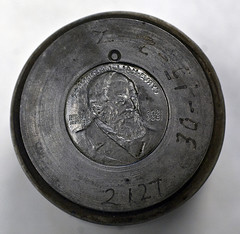
PREV ARTICLE
NEXT ARTICLE
FULL ISSUE
PREV FULL ISSUE
THE WATCHFOB MANUFACTURING PROCESS
Dick Johnson also submitted these comments relating to last week's great illustrated response by to Dick's earlier item by Bill Hyder.
-Editor
I assigned this die number when I cataloged all Medallic Art medals prior to 1977. The same number was applied to every item of that medal design, all tooling, patterns, dieshells and such. We even stamped that number on archive medals and all shop paper files. This single number system replaced five other number systems used previously throughout the firm. You see the loop at the top of the medal image. When it is in the die like this it is called INTEGRAL LOOP, attached to the medal when it is struck. It is very easy to add or remove a loop to a medal. It is possible to strike medals without the loop even with this die. Also there are numerous terms to describe a loop. There are eight types of loops of which Integral loop is the most common. When it is attached latter the loop can be soldered on, called SOLDERED LOOP. Also DRILLED AND TAPPED creating a threaded hole where a screw eye loop is attached. There are two types of swivel loops in which the medal can be turned over to show either side (prominent among English decorations). A loop that does not permit this is called a FIXED SUSPENDER. Sometimes a medal is struck with a LUG at the top, the loop is shaped from that, usually drilling a hole parallel with the medal. A wide loop -- to accommodate a leather strap as for a watchfob or ribbon -- is called a FOB LOOP. In contrast to the narrow loop shown on the die, called a BOB LOOP. The open space in the loop is called the EYE. A loop can also be called a BAIL Instead of an attached loop a round coin or medal can be placed inside a BEZEL a large ring completely enclosing the item. These are jewelry terms that have been brought over to the medallic field. Most loops are placed at the top of the medal. However, there are some ceremonial medals where the loop is placed at the bottom -- upside down to the viewer. These are used in a ceremony where the recipient holds up the medal so it is correct orientation for his viewing. Some Masonic medals are so designed. Some medals have two loops at the top, they are connected by links or chains, one link of which is a JUMP RING which opens and the adjacent link is inserted, then closed. This is often how a medal is attached to a HEADER. In such a hanging situation the medal is called a DROP. All this for the little rings of metal to suspend a medal so it may be worn. To read the earlier E-Sylum article, see: WATCH FOBS AS NUMISMATIC ITEMS (www.coinbooks.org/esylum_v16n15a15.html)
THE BOOK BAZARREWayne Homren, Editor The Numismatic Bibliomania Society is a non-profit organization promoting numismatic literature. See our web site at coinbooks.org. To submit items for publication in The E-Sylum, write to the Editor at this address: whomren@gmail.com To subscribe go to: https://my.binhost.com/lists/listinfo/esylum All Rights Reserved. NBS Home Page Contact the NBS webmaster 
|
